Mindfulness practices effectively reduce anxiety and promote emotional balance, enhancing overall well-being. Techniques like meditation and deep breathing help individuals focus on the present, lowering stress hormone levels. Integrating mindfulness into daily routines fosters self-awareness and emotional regulation. Understanding cultural variations in mindfulness can further enhance its effectiveness for anxiety relief.
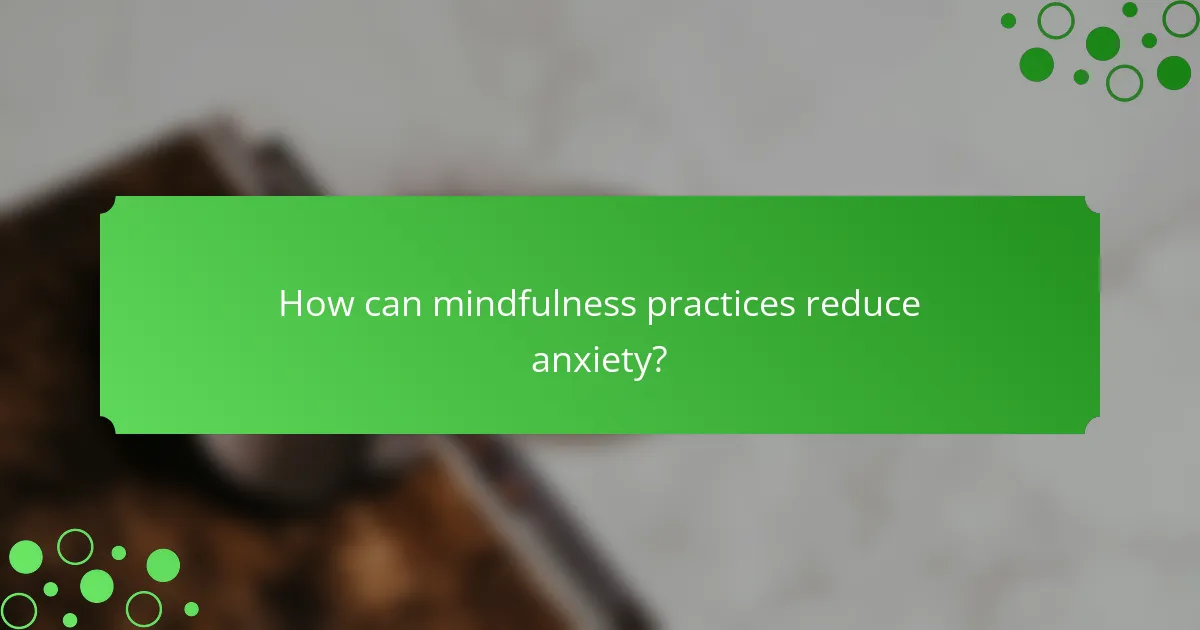
How can mindfulness practices reduce anxiety?
Mindfulness practices effectively reduce anxiety by promoting emotional balance and enhancing daily integration. Techniques such as meditation, deep breathing, and mindful observation help individuals focus on the present moment, which decreases anxiety levels. Research shows that regular mindfulness practice can lower cortisol, the stress hormone, leading to a calmer state of mind. Additionally, mindfulness fosters self-awareness, enabling better emotional regulation and resilience against anxiety triggers.
What are the physiological effects of mindfulness on anxiety?
Mindfulness practices significantly reduce anxiety by promoting emotional balance and enhancing daily integration. These techniques activate the parasympathetic nervous system, leading to physiological changes such as decreased heart rate and lower cortisol levels. Regular mindfulness meditation can improve focus and emotional regulation, fostering resilience against anxiety. Studies indicate that consistent practice may lead to structural brain changes, particularly in areas associated with stress response and emotional regulation.
Which mindfulness techniques are most effective for anxiety reduction?
Mindfulness techniques such as meditation, deep breathing, and body scanning are highly effective for reducing anxiety. These practices promote emotional balance and can be easily integrated into daily routines.
Meditation helps to center thoughts, fostering a sense of calm. Deep breathing exercises activate the body’s relaxation response, lowering stress levels. Body scanning increases awareness of physical sensations, aiding in emotional regulation. Regular practice enhances overall mental well-being and resilience against anxiety.
Studies show that consistent mindfulness practice can lead to significant reductions in anxiety symptoms. For example, participants in mindfulness programs reported a 30% decrease in anxiety levels after eight weeks. These techniques not only address immediate anxiety but also contribute to long-term emotional stability.
How does the duration of mindfulness practice influence anxiety levels?
The duration of mindfulness practice significantly reduces anxiety levels. Research indicates that longer and consistent practice leads to greater emotional regulation and lower anxiety symptoms. For instance, a study found that individuals practicing mindfulness for at least 8 weeks experienced a 30% reduction in anxiety levels. Regular engagement enhances the brain’s ability to manage stress responses. Additionally, mindfulness sessions of 20 minutes or more are linked to improved outcomes. The cumulative effect of practice time fosters deeper relaxation and resilience against anxiety triggers.
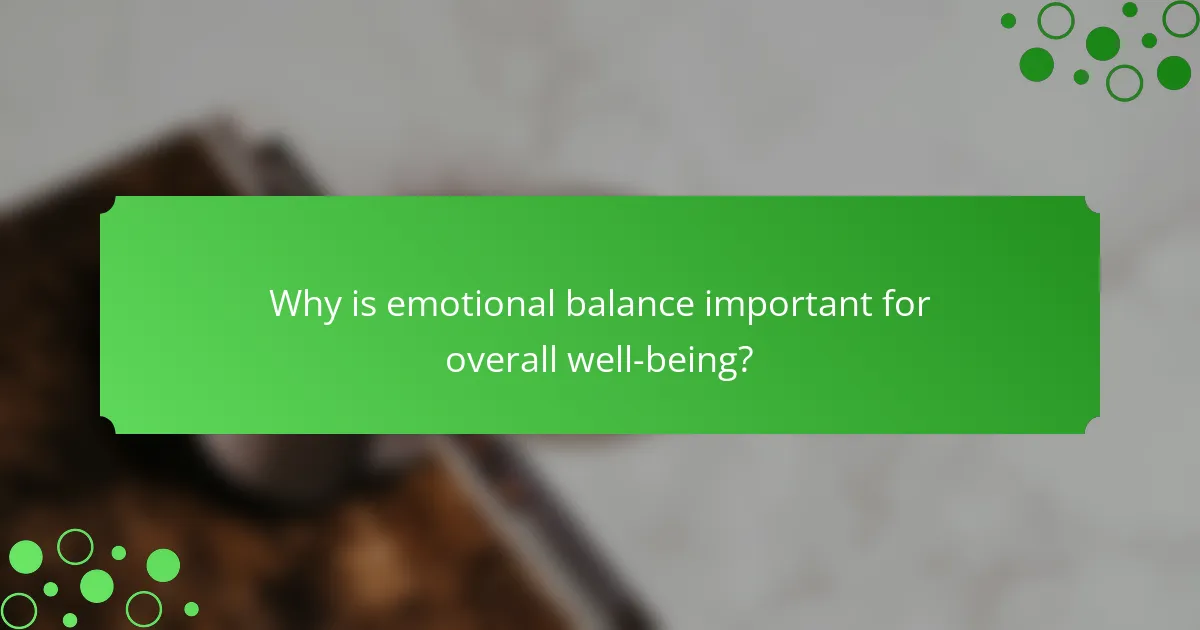
Why is emotional balance important for overall well-being?
Emotional balance is crucial for overall well-being as it enhances mental clarity and resilience. Mindfulness practices, such as meditation and deep breathing, help regulate emotions, reducing anxiety and stress. These techniques foster self-awareness, enabling individuals to respond to challenges more effectively. Regular integration of mindfulness into daily routines can lead to sustained emotional stability and improved quality of life.
What role does mindfulness play in achieving emotional balance?
Mindfulness significantly enhances emotional balance by promoting awareness and acceptance of thoughts and feelings. It fosters a non-judgmental approach, allowing individuals to process emotions without becoming overwhelmed. Regular mindfulness practices, such as meditation and deep breathing, can reduce anxiety and improve emotional regulation. Research shows that consistent mindfulness engagement can lead to a 30% reduction in anxiety levels, demonstrating its effectiveness in achieving emotional stability.
How can mindfulness practices help manage emotional triggers?
Mindfulness practices effectively help manage emotional triggers by promoting awareness and emotional regulation. Techniques such as meditation and deep breathing enhance self-awareness, allowing individuals to recognize and respond to triggers calmly. Regular practice fosters emotional balance, reducing anxiety and improving overall mental health. Research indicates that mindfulness can lower stress levels and improve resilience, making it a valuable tool for daily integration.
Which mindfulness exercises promote emotional regulation?
Mindfulness exercises that promote emotional regulation include deep breathing, body scan, and mindful observation. These practices enhance self-awareness and reduce anxiety, fostering emotional balance.
Deep breathing helps calm the nervous system, while the body scan promotes awareness of bodily sensations. Mindful observation encourages non-judgmental awareness of thoughts and feelings, contributing to emotional resilience. Regular integration of these exercises into daily routines strengthens emotional regulation skills.
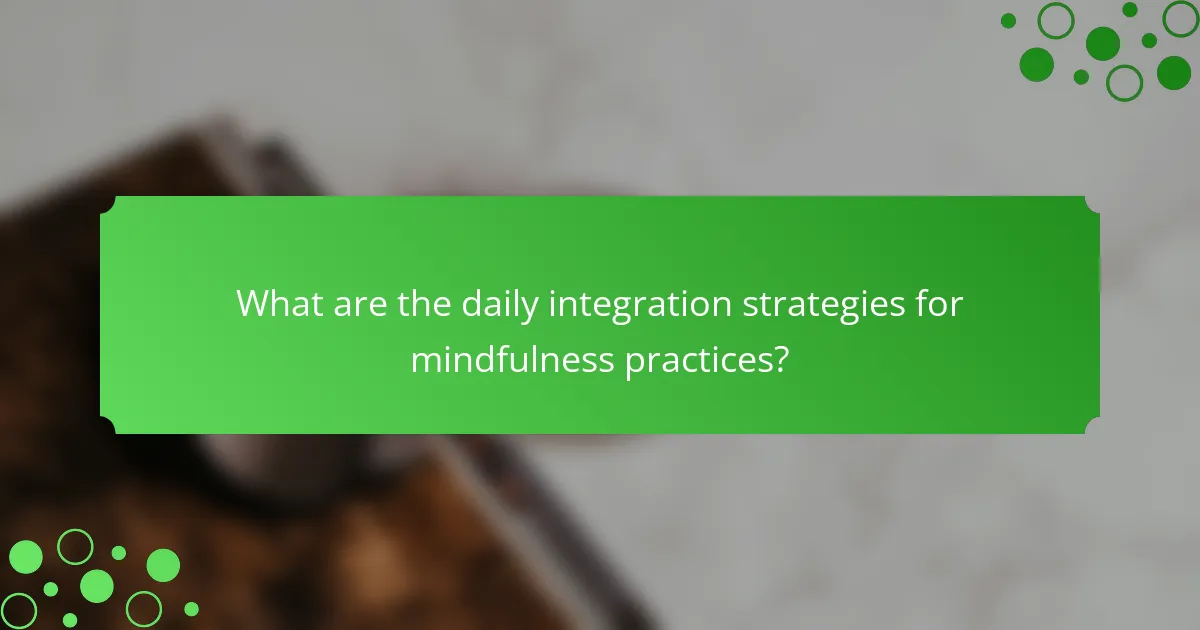
What are the daily integration strategies for mindfulness practices?
Daily integration strategies for mindfulness practices include setting specific times for practice, incorporating mindfulness into routine activities, and using reminders. Regularly practicing mindfulness for at least 10 minutes daily can enhance emotional balance and reduce anxiety. Techniques such as mindful breathing, body scans, and gratitude journaling can be easily integrated into everyday life. Engaging in mindful walking or eating during meals reinforces awareness and presence throughout the day.
How can mindfulness be incorporated into a busy lifestyle?
Mindfulness can be integrated into a busy lifestyle through simple, daily practices. Start with brief moments of awareness, such as deep breathing or mindful walking. Incorporate mindfulness into routine activities like eating or commuting by focusing on sensations and surroundings. Use reminders, such as phone alerts, to pause for mindfulness throughout the day. Engaging in short meditation sessions, even for five minutes, can enhance emotional balance and reduce anxiety. Consistency is key; aim to practice mindfulness regularly, making it a natural part of your daily routine.
What are the benefits of a structured mindfulness routine?
A structured mindfulness routine offers significant benefits for anxiety reduction, emotional balance, and daily integration. Regular practice enhances self-awareness, leading to better emotional regulation. It reduces stress by promoting relaxation and decreasing cortisol levels. Mindfulness also improves focus and cognitive flexibility, facilitating daily tasks. Furthermore, it fosters a sense of connection and compassion, enhancing interpersonal relationships. Engaging consistently with mindfulness can lead to long-term improvements in mental health and overall well-being.
Which tools and resources support daily mindfulness integration?
Mindfulness can be integrated into daily life using various tools and resources. Popular options include meditation apps, guided audio sessions, mindfulness journals, and online courses.
Meditation apps like Headspace and Calm offer structured programs for anxiety reduction. Guided audio sessions help maintain focus during practice. Mindfulness journals encourage reflection and emotional balance. Online courses provide comprehensive training in mindfulness techniques.
These resources support consistent practice, enhancing emotional well-being and reducing anxiety.
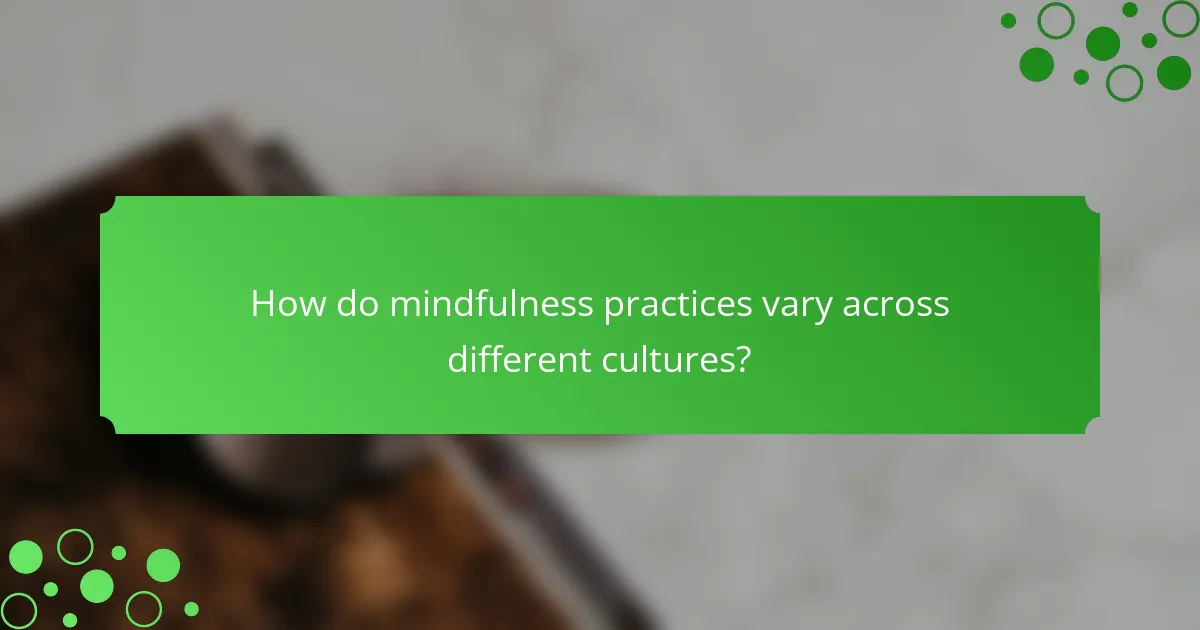
How do mindfulness practices vary across different cultures?
Mindfulness practices vary significantly across cultures, each offering unique approaches to anxiety reduction and emotional balance. In Eastern traditions, such as Buddhism, mindfulness often includes meditation techniques aimed at fostering awareness and presence. Western adaptations may incorporate cognitive behavioral strategies, emphasizing practical applications in daily life.
For example, in Japan, Zen practices focus on simplicity and breathing techniques, while in India, mindfulness may integrate yoga and self-reflection. African cultures often emphasize communal practices and storytelling to promote emotional well-being.
These diverse methods highlight the unique attributes of mindfulness, showcasing how cultural contexts shape the practice and its integration into daily routines. Understanding these variations can enhance the effectiveness of mindfulness for individuals seeking emotional balance and anxiety relief.
What unique mindfulness traditions exist in various regions?
Various regions have unique mindfulness traditions that aid in anxiety reduction, emotional balance, and daily integration. For instance, Zen Buddhism in Japan emphasizes breath awareness and seated meditation, fostering present-moment focus. Tibetan Buddhism incorporates visualization and mantra recitation, promoting emotional healing through compassion. In India, Yoga practices blend physical postures with breath control, enhancing mental clarity and emotional stability. Mindfulness-Based Stress Reduction (MBSR), developed in the United States, combines elements from these traditions, making mindfulness accessible to a broader audience. Each tradition offers distinct techniques that contribute to overall well-being.
How do cultural perceptions influence mindfulness practices?
Cultural perceptions significantly shape mindfulness practices by influencing their interpretation and application. Different cultures emphasize various aspects of mindfulness, affecting its effectiveness for anxiety reduction and emotional balance. For instance, Eastern traditions often focus on meditation and awareness, while Western approaches may integrate cognitive behavioral techniques. These cultural nuances can lead to unique attributes in practice, such as community involvement or individualistic approaches, impacting daily integration. Understanding these differences enhances the ability to adapt mindfulness practices to diverse contexts, promoting broader acceptance and effectiveness.
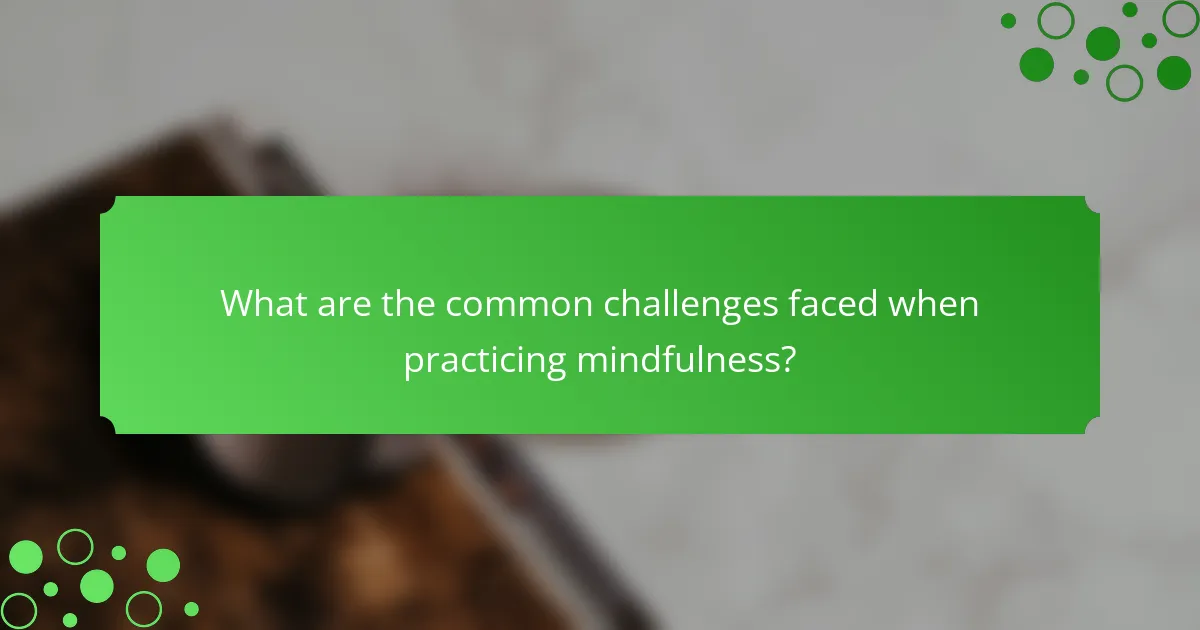
What are the common challenges faced when practicing mindfulness?
Common challenges when practicing mindfulness include distractions, difficulty focusing, emotional resistance, and unrealistic expectations. These obstacles can hinder anxiety reduction and emotional balance. Practitioners may struggle to integrate mindfulness into daily routines, leading to inconsistent practice. Overcoming these challenges often requires patience, commitment, and tailored strategies to enhance the mindfulness experience.
How can one overcome barriers to consistent mindfulness practice?
To overcome barriers to consistent mindfulness practice, establish a routine and set realistic expectations. Create a dedicated space for practice to minimize distractions. Start with short sessions, gradually increasing duration as comfort grows. Utilize guided meditations or mindfulness apps to enhance engagement. Regularly reflect on progress to reinforce motivation.
What misconceptions about mindfulness might hinder practice?
Misconceptions about mindfulness can significantly hinder its practice. Common myths include the belief that mindfulness requires emptying the mind, that it is solely about relaxation, and that it demands extensive time commitment. These misunderstandings can lead to frustration and discouragement, preventing individuals from experiencing the benefits of mindfulness for anxiety reduction and emotional balance. Recognizing that mindfulness is about awareness and acceptance, rather than a specific state of mind, can enhance daily integration and effectiveness.
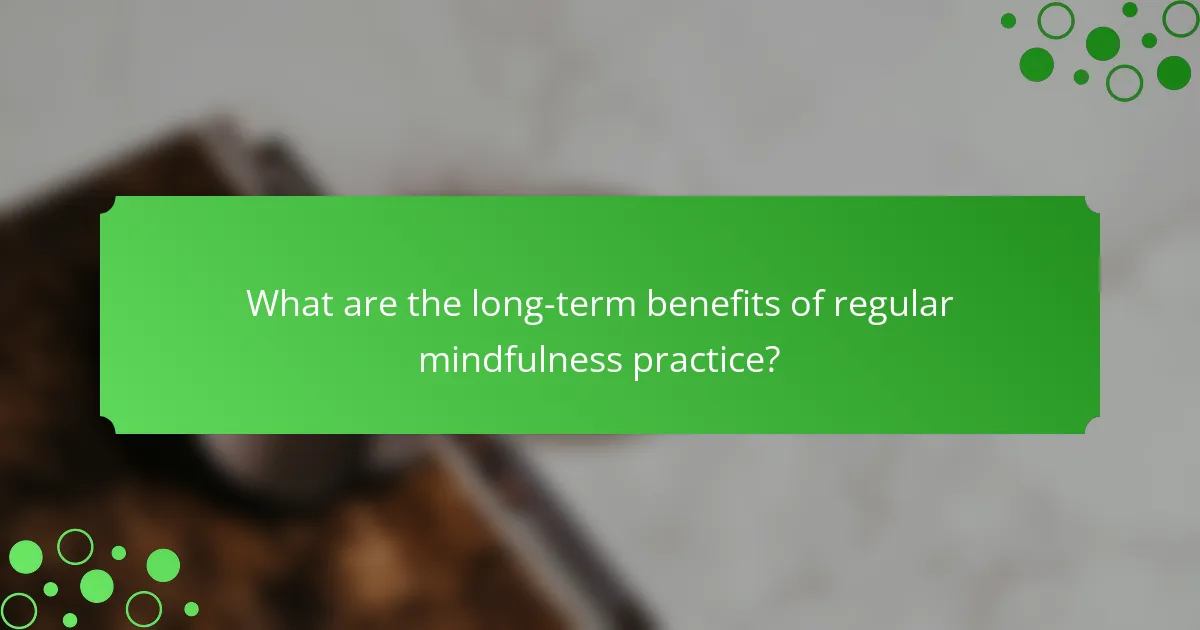
What are the long-term benefits of regular mindfulness practice?
Regular mindfulness practice offers long-term benefits such as reduced anxiety, improved emotional balance, and enhanced daily integration. These benefits stem from consistent engagement with mindfulness techniques, which promote greater awareness and resilience.
Research indicates that mindfulness can lead to a significant decrease in anxiety levels. A study found that participants who practiced mindfulness regularly reported a 58% reduction in anxiety symptoms over six months. This effect is attributed to mindfulness fostering a non-judgmental awareness of thoughts and feelings, allowing individuals to manage stress more effectively.
Emotional balance is another key benefit. Mindfulness cultivates emotional regulation by enhancing self-awareness and promoting a more balanced perspective on experiences. This leads to improved interpersonal relationships and greater overall life satisfaction.
Daily integration of mindfulness practices can transform routines and enhance well-being. Simple techniques like mindful breathing or body scans can be incorporated into daily life, making mindfulness accessible and practical. This consistent practice reinforces the positive effects on mental health, creating a sustainable cycle of well-being.
How does mindfulness contribute to resilience and coping skills?
Mindfulness enhances resilience and coping skills by promoting emotional regulation and stress reduction. Regular mindfulness practices, such as meditation and deep breathing, help individuals manage anxiety and cultivate a balanced emotional state. Research indicates that these practices can decrease cortisol levels, leading to improved stress responses. Furthermore, integrating mindfulness into daily routines fosters a greater sense of awareness and adaptability, contributing to overall mental well-being.
What evidence supports the effectiveness of mindfulness for mental health?
Research shows mindfulness practices significantly reduce anxiety and promote emotional balance. Studies indicate that regular mindfulness meditation can lower cortisol levels, improve mood, and enhance overall mental well-being. For instance, a meta-analysis found mindfulness-based interventions lead to moderate reductions in anxiety symptoms across diverse populations. Additionally, participants often report improved emotional regulation and resilience, suggesting long-term benefits. Daily integration of mindfulness techniques, such as breath awareness or body scans, can further support mental health by fostering a greater sense of presence and reducing stress.
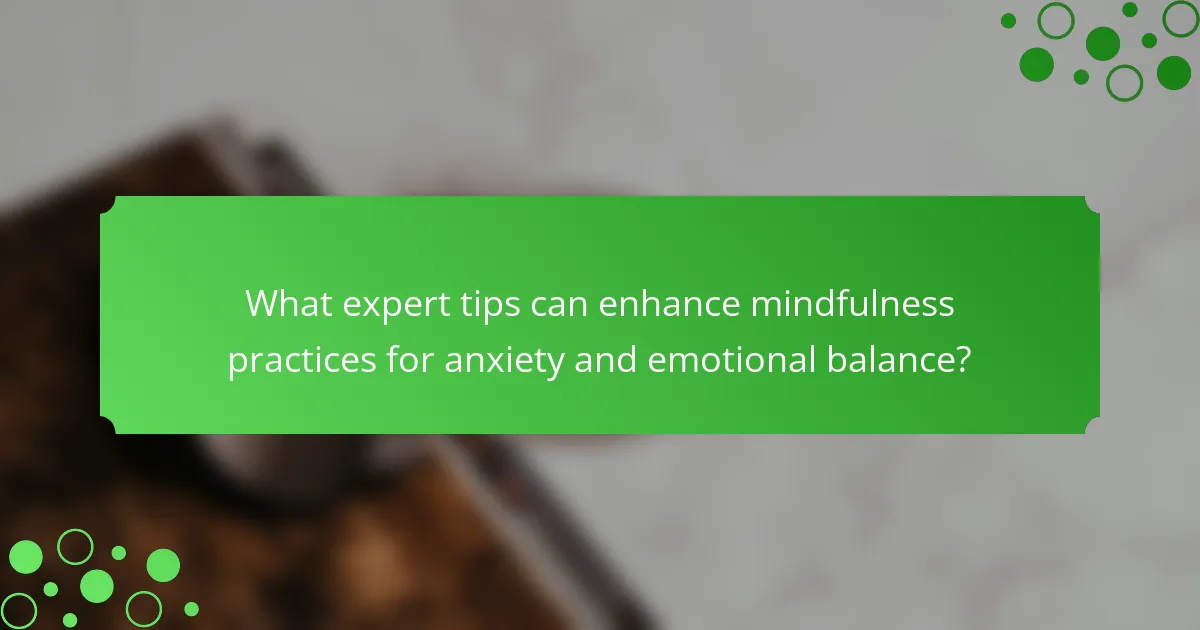
What expert tips can enhance mindfulness practices for anxiety and emotional balance?
Incorporating expert tips can significantly enhance mindfulness practices for anxiety reduction and emotional balance. Focus on consistent daily practice, even for short durations, to build resilience.
1. Establish a routine: Set aside specific times for mindfulness to create a habit.
2. Use guided meditations: Leverage apps or online resources for structured sessions.
3. Incorporate breathwork: Deep, intentional breathing can center your thoughts and emotions.
4. Engage in mindful movement: Activities like yoga or tai chi integrate mindfulness with physical activity.
5. Practice gratitude: Regularly acknowledging what you are thankful for can shift focus from anxiety.
6. Reflect on your experiences: Journaling about your mindfulness journey can reinforce learning and growth.
These strategies can foster a deeper connection to the present moment, enhancing emotional stability.
Which common mistakes should be avoided in mindfulness practice?
To enhance mindfulness practices for anxiety reduction, avoid common mistakes that hinder progress. Key mistakes include neglecting consistency, focusing too much on perfection, and underestimating the importance of the breath.
1. Inconsistency in practice leads to diminished benefits. Regular engagement is essential for emotional balance.
2. Perfectionism can create unnecessary pressure, making mindfulness feel like a chore rather than a tool for relaxation.
3. Ignoring the breath limits the practice’s grounding effect, which is vital for daily integration and stress relief.
4. Overthinking the process can detract from the experience, preventing genuine emotional connection and awareness.
By steering clear of these pitfalls, individuals can cultivate a more effective mindfulness practice that supports their mental well-being.
How can one measure the impact of mindfulness on anxiety and emotions?
Mindfulness can significantly reduce anxiety and enhance emotional balance. To measure its impact, consider using self-report scales, physiological indicators, and behavioral assessments.
Self-report scales like the State-Trait Anxiety Inventory quantify anxiety levels before and after mindfulness practices. Physiological indicators, such as heart rate variability, reflect stress response changes. Behavioral assessments track improvements in emotional regulation and daily functioning.
Research indicates that consistent mindfulness practice can lower anxiety levels by up to 30% within eight weeks. Regular monitoring of these metrics provides insights into mindfulness effectiveness.
What resources are recommended for deepening mindfulness practice?
To deepen mindfulness practice, consider resources that enhance anxiety reduction, emotional balance, and daily integration. Recommended resources include guided meditation apps, mindfulness books, online courses, and local workshops.
1. Guided Meditation Apps: Headspace, Calm, Insight Timer
2. Mindfulness Books: “The Miracle of Mindfulness” by Thich Nhat Hanh, “Wherever You Go, There You Are” by Jon Kabat-Zinn
3. Online Courses: Mindful Schools, Coursera mindfulness courses
4. Local Workshops: Community centers, yoga studios, mental health organizations
These resources provide structured approaches to integrate mindfulness into daily life.